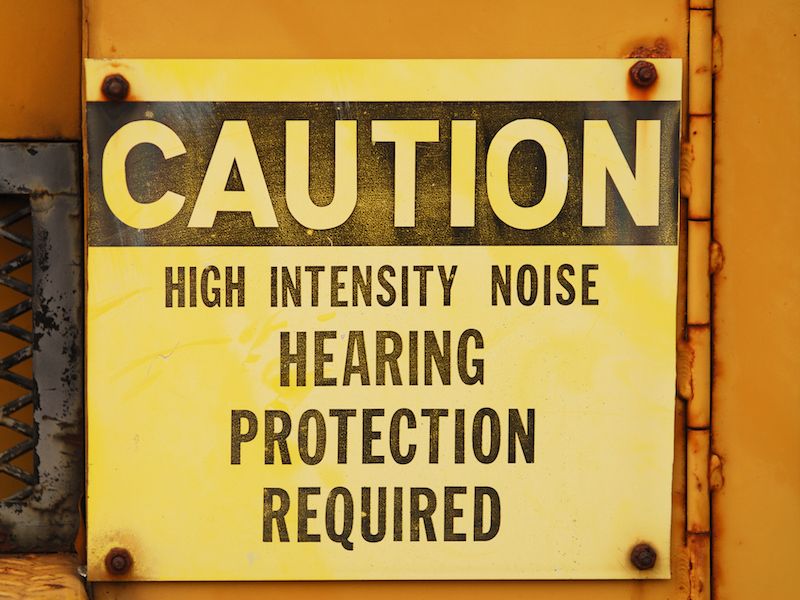
Realizing you need to safeguard your hearing is one thing. Recognizing when to protect your ears is a different story. It’s not as easy as, for example, determining when to use sunblock. (Is it sunny and will you be outside? Then you need sunscreen.) Even recognizing when you need eye protection is simpler (Doing some hammering? Cutting some wood or working with dangerous chemicals? Wear eye protection).
With regards to when to use hearing protection, there seems to be a huge grey area which can be dangerous. Unless we have particular information that some place or activity is dangerous we tend to take the easy path which is to avoid the issue altogether.
Risk Evaluations
In general, we’re not very good at assessing risk, especially when it comes to something as intangible as permanent hearing problems or loss of hearing. Here are some examples to demonstrate the situation:
- A very loud rock concert is attended by person A. The concert lasts roughly 3 hours.
- Person B owns a landscaping business. After mowing lawns all day, she goes home and quietly reads a book.
- Person C is an office worker.
You may think that person A (let’s call her Ann, to be a little less formal) might be in more hearing danger. For most of the next day, her ears will still be ringing from the loud performance. Assuming Ann’s activity was hazardous to her ears would be sensible.
Person B (let’s just call her Betty), on the other hand, is exposed to less noise. Her ears don’t ring. So her hearing must be less hazardous, right? Not necessarily. Because Betty is pushing that mower all day. So although her ears never ring out with pain, the damage builds up little by little. Even moderate noises, if experienced with enough frequency, can harm your ears.
What’s occurring with person C (let’s call her Chris) is even harder to make sense of. Lawnmowers come with instructions that emphasize the dangers of continued exposure to noise. But while Chris works in a quiet office, she has a very noisy, hour-long commute every day through the city. What’s more, she sits behind her desk and listens to music through earbuds. Does she need to give some thought to protection?
When is it Time to Begin to Think About Safeguarding Your Ears?
The normal guideline is that if you need to raise your voice to be heard, your surroundings are noisy enough to do injure to your hearing. And you need to think about wearing earmuffs or earplugs if your surroundings are that noisy.
The limit should be 85dB if you want to be clinical. Sounds above 85dB have the capacity, over time, to lead to damage, so in those circumstances, you should think about wearing hearing protection.
Your ears don’t have their own sound level meter to alert you when you reach that 85dB level, so most hearing professionals recommend getting specialized apps for your phone. These apps can inform you when the surrounding noise is approaching a hazardous level, and you can take suitable steps.
A Few Examples
Even if you do get that app and take it with you, your phone may not be with you wherever you go. So we may formulate a good standard with a few examples of when to safeguard our hearing. Here we go:
- Exercise: You know your morning cycling class? Or maybe your evening yoga session? All of these examples may require hearing protection. The high volume from instructors who use loud music and microphones for motivation, though it may be good for your heart rate, can be bad for your ears.
- Commuting and Driving: Do you drive for Lyft or Uber? Or perhaps you’re just hanging around downtown for work or boarding the subway. The noise of living in the city is bad enough for your hearing, not to mention the extra damage caused by turning up your tunes to drown out the city noise.
- Using Power Tools: You understand you will need hearing protection if you work all day in a factory. But what if you’re simply puttering around your garage all day? Even if it’s only a hobby, hearing specialists recommend wearing hearing protection if you’re working with power equipment.
- Domestic Chores: Even mowing a lawn, as previously stated, calls for hearing protection. Chores, like mowing, are most likely something you don’t even think about, but they can result in hearing damage.
- Listening to music with earbuds. This one calls for caution, not protection. Whether your music is going directly into your ears, how loud it is playing, and how long you’re listening to it are all things you should give consideration to. Noise-canceling headphones are a good choice to avoid needing to turn the volume way up.
A good baseline may be researched by these examples. If there is any doubt, however, use protection. Instead of leaving your ears exposed to future harm, in most instances, it’s better to protect your ears. If you want to be able to hear tomorrow, protect today.